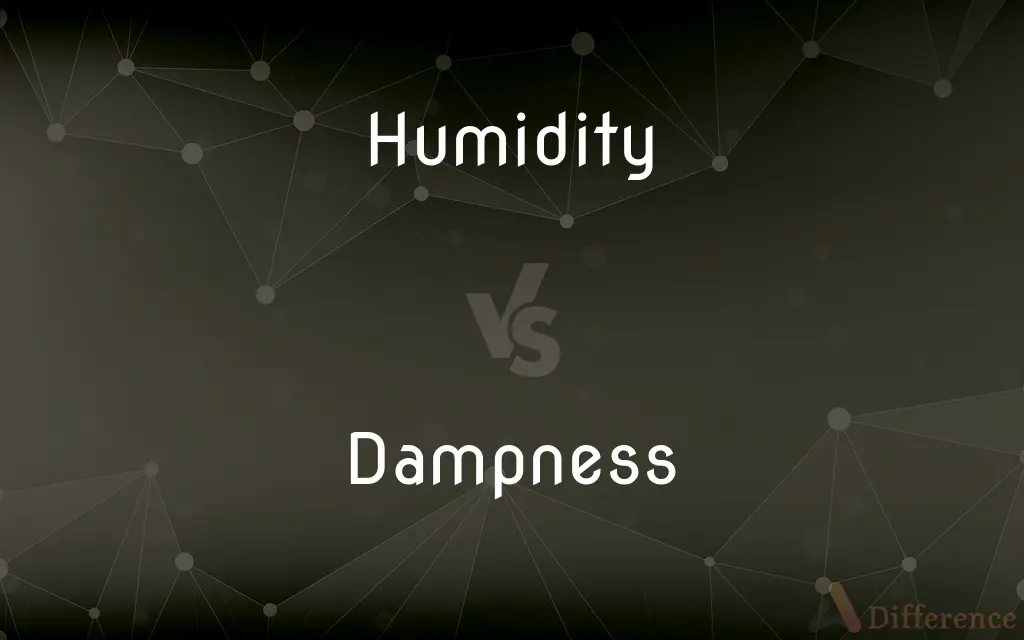Humidity vs. Dampness — What's the Difference?
By Tayyaba Rehman — Published on September 5, 2023
Humidity refers to the amount of moisture in the air, while dampness denotes the presence of moisture on surfaces or objects.

Difference Between Humidity and Dampness
Table of Contents
ADVERTISEMENT
Key Differences
Humidity and dampness are both related to the presence of moisture, but they are applied in different contexts. Humidity is about the water vapor present in the atmosphere, whereas dampness is about the wetness that can be felt on materials or surfaces.
When discussing humidity, it's often in the context of weather or indoor environments, indicating how much water vapor the air holds. On the other hand, dampness is typically used when referring to wet or moist conditions on walls, floors, clothes, or other objects.
A high humidity level can lead to feelings of discomfort, especially in warm temperatures, as it affects the body's ability to cool itself. Dampness in homes, however, is more associated with structural issues, potential mold growth, and a chilly sensation in a building.
Humidity can be measured using a device called a hygrometer, which will give a percentage indicating the amount of moisture in the air. Dampness, conversely, is often detected through touch, sight, or specific moisture meters that evaluate the moisture content in materials.
It's also worth noting that high humidity in an environment can often lead to dampness on surfaces, especially when there's a lack of adequate ventilation, making the two concepts interrelated in certain situations.
ADVERTISEMENT
Comparison Chart
Context of Use
Atmospheric moisture
Moisture in/on materials or surfaces
Measurement
Given as a percentage
Often qualitative (e.g., feels damp) or by specific meters
Associated Devices
Hygrometer
Moisture meter
Effects
Affects body's cooling & comfort
Can cause mold, structural issues
Caused By
Various factors including weather and indoor conditions
Lack of ventilation, water intrusion, high humidity
Compare with Definitions
Humidity
The amount of water vapor in the air.
The humidity today is making it feel even hotter outside.
Dampness
The state of being slightly wet.
The dampness in the basement is a concern.
Humidity
A measure of atmospheric moisture.
High humidity levels often make hair frizzy.
Dampness
Moisture on or in materials or surfaces.
There's a noticeable dampness on the walls after the rain.
Humidity
Can be absolute (grams of water per volume of air) or relative (percentage).
The weather report says the relative humidity will be 85% tomorrow.
Dampness
Often associated with cool or chilly conditions in buildings.
The dampness in the room made it feel colder than it was.
Humidity
Influences comfort and perceived temperature.
Even though it's 80°F, the high humidity makes it feel like 90°F.
Dampness
Slightly wet
A damp sponge.
Humidity
The content of water vapor in the air, expressed as a percent of the maximum amount of water vapor that the air can hold at the given temperature; also called relative humidity. The capacity of the air to hold moisture increases with temperature, so if the temperature changes without changing the absolute content of the atmospheric moisture, the relative humidity will also change.
Dampness
(Archaic) Dejected; depressed.
Humidity
The amount of water vapour in the air.
Dampness
Humid
Damp air.
Humidity
A critical factor for certain industries like woodworking or electronics.
Proper humidity control is essential in the production of semiconductors.
Dampness
A result of water intrusion or lack of ventilation.
Poor ventilation in the bathroom has caused dampness and peeling paint.
Humidity
Humidity is the concentration of water vapour present in the air. Water vapor, the gaseous state of water, is generally invisible to the human eye.
Dampness
Moisture in the air; humidity
Come in out of the damp.
Humidity
Dampness, especially of the air.
Dampness
Moisture that lies or has condensed on something
“I saw the damp lying on the bare hedges and spare grass” (Charles Dickens).
Humidity
Relative humidity.
Dampness
Foul or poisonous gas that sometimes pollutes the air in coal mines.
Humidity
Dampness, especially that of the air.
Dampness
Lowness of spirits; depression
“An angry or sorrowful [countenance] throws a sudden damp upon me” (David Hume).
Humidity
Wetness in the atmosphere
Dampness
A restraint or check; a discouragement
“The issue of arms was so slow as to throw a great damp upon volunteering” (James Franck Bright).
Humidity
Moisture; dampness; a moderate degree of wetness, which is perceptible to the eye or touch; - used especially of the atmosphere, or of anything which has absorbed moisture from the atmosphere, as clothing.
Dampness
To make damp or moist; moisten.
Dampness
To suppress or extinguish (a fire) by reducing or cutting off air.
Dampness
To restrain or check
News that damped our enthusiasm.
Dampness
(Music) To slow or stop the vibrations of (the strings of a keyboard instrument) with a damper.
Dampness
(Physics) To decrease the amplitude of (an oscillating system).
Dampness
Moderate humidity; moisture; moistness; the state or quality of being damp.
Dampness
The degree to which something is damp or moist.
The dampness in the writing paper caused the ink to spread and smudge.
Dampness
A slight wetness
Dampness
Moderate humidity; moisture; fogginess; moistness.
Common Curiosities
Can high humidity lead to dampness on surfaces?
Yes, high humidity can cause condensation on surfaces, leading to dampness.
Are certain areas more prone to dampness?
Yes, areas with poor ventilation or where water intrusion occurs, like basements, are often prone to dampness.
What does "humidity" refer to?
Humidity refers to the amount of water vapor present in the air.
How is "humidity" typically measured?
Humidity is usually measured as a percentage, often with a hygrometer.
How can one detect dampness in materials?
Dampness is often detected through touch, sight, or using specific moisture meters.
How can one reduce humidity in a room?
Using dehumidifiers, increasing ventilation, or using air conditioners can help reduce humidity.
Is "dampness" the same as "humidity"?
No, while both relate to moisture, dampness refers to the presence of moisture on surfaces or objects, whereas humidity is about atmospheric moisture.
Why is "dampness" in homes a concern?
Dampness can lead to mold growth, structural issues, and a chilly sensation in a building.
What device measures humidity?
A hygrometer is commonly used to measure humidity.
Is dampness only related to water?
While dampness typically refers to the presence of water moisture, it can also be related to other liquids if they cause materials or surfaces to become wet.
Share Your Discovery

Previous Comparison
Task vs. Process
Next Comparison
Purpose vs. AimAuthor Spotlight
Written by
Tayyaba RehmanTayyaba Rehman is a distinguished writer, currently serving as a primary contributor to askdifference.com. As a researcher in semantics and etymology, Tayyaba's passion for the complexity of languages and their distinctions has found a perfect home on the platform. Tayyaba delves into the intricacies of language, distinguishing between commonly confused words and phrases, thereby providing clarity for readers worldwide.














































